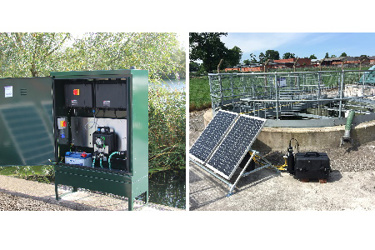Monitoring Data Can Underpin River Quality Improvements

The UK’s Environmental Audit Committee (EAC) has requested written evidence from Meteor Communications, the specialist provider of remote water quality monitoring systems, as part of the committee’s ongoing inquiry into water quality in rivers. The submission was timely because it was made while sewage spills were the subject of intense media attention, and after the Environment Act 2021 placed a new responsibility on sewerage undertakers to progressively reduce the impact of discharges from storm overflows.
“We have been following the EAC enquiry closely,” explains Meteor Technical Director Andrew Scott, “and with over 300 of our ESNET outstations currently monitoring UK rivers, we were concerned that some of the participants may not be fully aware of this technological capability.
“Conveniently, data from the Environment Agency’s pollution investigations were recently made public, so we were able to show the EAC examples of the ways in which our technology is able to continuously track the key signatures for different types of pollution, and how these can be correlated with events such as heavy rainfall; delivering legally defensible information.”
Following an online meeting with representatives of the EAC, Meteor staff were asked to provide a written submission, describing the current monitoring networks and explaining how these could be upscaled to monitor downstream and upstream of sewage treatment works in England.
There are two main types of ESNET (Environmental Sensor NETwork) water quality monitoring system; a portable monitoring station, and a kiosk-housed pumped system for semi-permanent or fixed installations. The systems were developed to allow rapid deployment with no requirement for pre-existing power or communication infrastructure. As a result, high resolution, real-time, multiparameter water quality data can be obtained within minutes of deployment.
ESNET monitors are typically loaded with sensors for parameters such as dissolved oxygen, pH, conductivity, turbidity, ammonium, temperature, blue green algae and chlorophyll. However, it is also possible to include other water quality parameters as well as remote cameras, water level and flow, or meteorological measurements. The addition of autosamplers enables the collection of samples for laboratory analysis; either at pre-set intervals and/or initiated by specific alarm conditions. This is a particular advantage for water companies and regulators because it enables the immediate collection of samples in response to a pollution incident, which informs mitigation measures and helps to identify the source of contamination.
The EAC inquiry follows increasing concern about water quality in rivers, with just 14% of English rivers currently achieving ‘Good’ ecological status and no river rated ‘Good’ on its chemical status. It has also been reported that in 2020 there were over 400,000 discharges of raw sewage into English rivers.
Looking forward Andrew says: “All stakeholders are currently looking for ways to improve water quality in rivers, and effective continuous monitoring of receiving waters will perform a vital role in achieving that objective. In addition, the Environment Act 2021 places a new responsibility for monitoring the quality of watercourses into which storm overflows discharge.
“Water companies, regulators, consultants and water users can therefore be reassured that proven technology exists to better understand the factors affecting the quality of receiving waters.”
About Meteor Communications Ltd
For over 25 years, Meteor Communications has designed, built and installed remote environmental monitoring systems for global governmental, utility, industrial, consulting and academic organisations. Innovation underpins the success of the company, and all products and solutions have been developed in close cooperation with customers.
Meteor’s products provide real-time access to vitally important field data, with two main themes. Remote water quality monitoring stations measure background levels, enabling trend analysis and the identification of pollution from diffuse and point sources. Remote, low-power, rugged cameras provide visualisation of key assets such as construction sites, flood gates, weirs, flumes, screens, grills etc. Both the cameras and the water quality monitoring stations provide immediate access to current conditions with alarm capability, which enables prompt remedial action, as well as the optimisation of maintenance activities.
Meteor Communications provides a wide range of off-the-shelf and bespoke monitoring solutions. Most can be deployed within minutes, are solar powered and do not require significant infrastructure to run. Cloud-based data is accessed via secure login to the Meteor Communications data centre. This is achieved using any web-enabled device and provides instant access to live and stored data, which includes an interactive graphical display.
Meteor Communications has a large installed base of remote monitoring stations and the company’s turnover has increased 5-fold in the last 6 years. For more information, visit www.meteorcommunications.co.uk
Source: Meteor Communications Ltd
